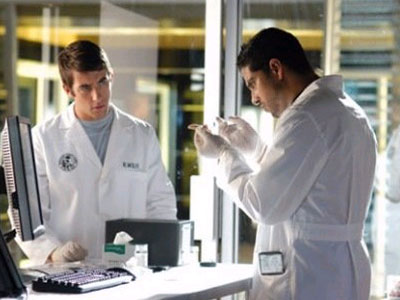DNA Crime Lab Analysis: TV vs. Reality

They gather in a shiny lab. They exchange quips. They jiggle a few test tubes. They push buttons on a computer and—bingo—another case is solved.
Yes, that's the wonderful world of DNA as it's used to solve crimes by modern police forces — at least that's what you see on TV.
The reality is a lot less photogenic.
"I think the biggest trend caused by what I call the TV effect is that people expect there to be substantiating DNA results in any court case," complains Tina Delgado, forensic DNA examiner in the FBI's DNA Analysis Unit. "But if you think about something like a drive-by shooting, there will not be any DNA."
The other big misconception she pointed out is that the process is in any way instantaneous. In cases where someone's life is at stake the FBI lab can perform an analysis in 48 hours, she said, but typically it takes weeks to get a result. (Some of that time is due to the lab's work backlog, but she could not comment on that.)
Tedious process
The first step in the process, Delgado explained, is to find a suitable DNA sample. That usually means combing through bags of evidence—often clothing—that the investigators have sent to the lab. Just what they are looking for can be different each time.
Get the world’s most fascinating discoveries delivered straight to your inbox.
"You may want to know who wore the shirt, or who bled on the shirt," she explained.
Once located, the DNA is extracted from the material it's mixed with, and then the amount of extracted DNA is measured. The lab needs to obtain 1 or 2 nanograms, which she described as one billionth of a one-gram Sweet 'N Low coffee sweetener packet, or a tiny fraction of a single saccharin crystal.
The material is then put to what she called a molecular copying machine which labels the DNA as it copies it, and the results are then fed into a genetic analyzer. They then get the results—maybe.
Results
"Just because you can run an analysis doesn't mean you'll get results," Delgado said. "Sunlight, heat, humidity, and age can all damage DNA. We have successfully analyzed material that had been in police evidence lockers at room temperature for decades, but DNA can go bad if left out in the sun for even a few days."
And some people leave behind more DNA than others, "depending on the amount of oil on their skin, how recently they washed their hands, or whether they were wearing lipstick," she added.
The genetic analyzer looks at 13 different locations on the DNA, locations not known to be related to any physical characteristic but that are known to vary widely between individuals, Delgado explained. Damaged samples that lack all 13 locations cannot serve to positively identify someone, but could still be used to exclude suspects.
In some cases investigators can only tell if the DNA was from a male or female, but that single fact can still be valuable, she noted.
"But if the sample is in good shape it's common to get all 13 locations," she said.
DNA samples that are known to have come from a perpetrator are put in the FBI's database of offender samples, which now has 5 million files. DNA from innocent bystanders is not added to the database, she said.
- The Reality of Fingerprinting Not Like TV Crime Labs
- Pet DNA Help CSIs Take a Bite Out of Crime
- The Most Popular Myths in Science


